Background
The Humboldt State University Dominicana Program for, summer of 2012, has partnered with Universidad Iberoamericana, RevArt, and community members of La Yuca to improve the rainwater catchment system that was built during the 2011 Humboldt State Dominicana Program. The program takes place in Santo Domingo, Dominican Republic. The rainwater catchment system of 2011, produced water that is frequently used in La Yuca for cleaning. However, the system had problems producing drinkable water. Our group’s goal was to improve the quality of water filtration so that rainwater catchment may be used to supply drinkable water for the grammar school in La Yuca. This will save the school an average of RD$300 a week. The system was also simplified and made more accessible for maintenance and repair. The involvement of La Yuca community members and Universidad Iberamericana students ensued that the system would be maintained well after the program’s end and also lead us to make the project more efficient based on the wants and needs of the community.
Problem Definition
The objective of this project is to provide inexpensive potable water and cleaning water for the local school in La Yuca, Santo Domingo. Replacing purchased water with captured water will allow funds to be allocated for other important services.
Criteria
Criteria is a compilation of goals that are necessary to reach a final design. These criteria are designed to ensure that the project meets what the community of La Yuca wants.
| Criteria | Weight | Constraints |
|---|---|---|
| Aesthetics | 3 | Must be acceptable to the client |
| Ease of maintenance | 8 | Maintenance must be simple, quick and understandable |
| Safety | 10 | Must be safe for children to play around. Water must be potable. |
| Reproducibility | 9 | Must be replicable in similar situations with minor modifications |
| Adaptability | 8 | Must be flexible to changes desired by the user |
| Reproduction cost | 9 | Must be less than $1000 US |
| R&D cost | 3 | Must be less than $1000 US |
| O&M cost | 10 | Must be less than purchasing the same amount of potable water |
| Educational Value | 9 | Can be used for lessons by teachers |
| Durability | 9 | Must withstand strong tropical storms |
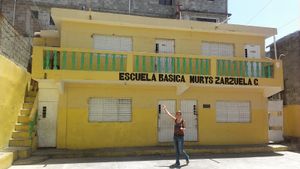
Literature Review
The Roof
The size of the roof for the area of catchment is determined by the amount of water being harvested.The use of a metal roof is better than one that is textured, such as tile, because a metal roof attains a smooth surface that allows debris to build up and other pollutants such as dust to easily slide off of the roof during rain. The ability of metal to conduct heat from the sun allows a metal roof to partially kill some bacteria and other pathogens on the roof during full sun. When considering what material may be best for your system it is important to consider that certain metals leach toxic chemicals into water. Avoid using bitumen, this metal is directly associated with adverse health affects and leaves an undesirable flavor in potable water after treatment. The seepage of Aluminum into water is linked with potentially being a cause of Alzheimer’s disease. Aluminum is commonly used as the material that makes up the roof of a catchment system but is often questioned due to the health risks that are associated with the use of this material. While zinc is known to undergo the seepage of toxins into a system, the amount of zinc present in a steal roof galvanized in zinc is not enough to pose a health threat.It is vital to consider what metals experience fewer problems with rust. Reducing the amount of rust that may exist on the catchment roof will improve the quality of the water and save money on materials and maintenance. Metals that experience issues with rust earlier will negatively impact a system and prolong the system’s buy back time.[1]
The Gutter
The gutter is used to transport water from the catchment surface to the first flush. The efficiency at which the gutter collects runoff water from the roof is dependent on the placement of the gutter. If the slope of the gutter is too steep, a partial amount of the runoff water will flow over the gutter. If the slope of the gutter is leveled, not all of the runoff water will flow out of the gutter into primary screening. Water left to set in the gutter will form stagnate water. Stagnate water poses a risk of algae growth and production of Mosquito larva. It is a useful precaution to place an end cap on the gutter so that rodents and other small animals are unable to enter the system. Seamless aluminum gutters are sustainable for the system. However, these gutters are not cost efficient for the system, they usually require professional installation at expensive rates. Lead gutters are never good for rainwater harvesting. The acidic levels present in rain are strong enough to deteriorate lead gutters over time and cause seepage of lead into the system, contaminating the entire water supply. [2]
Primary Screening
In between periods of rainfall, debris, air pollutants, dust, animal fecal matter, and various other particles collect on the collection surface. During the first rainfall these items will be cleansed off of the collection surface and enter the system. Debris and pollutants entering the storage tank will significantly lower the quality of water and affect the ability of making the water potable. To avoid damage to the quality of water in a system, primary screening is necessary. Primary screening is a screen that prevents large debris from entering the system. The use of primary screening limits the probability of blockages forming, causing a detriment to the amount of time in which water is harvested. [3]
Liter of Light
The liter of light is a sustainable lighting project that aimed to bring eco-friendly solar bottle bulbs to communities in The Philippines. Designed and developed by students from Massachusetts Institute of Technology (MIT)- the solar bottle bulb is based on the principles of Appropriate Technologies and is a concept that provides simple and easily replicable technologies that address basic needs in developing communities. [4]
First Flush
A roof can be a natural collector of dust, plant debris, insects, animal feces, and other airborne residues. Rainwater that contacts a dirty roof must not be stored. A first flush is used to divert contaminated water away from the storage tank. Contaminated water is rerouted in a length of pipe that is capped at the end. There are varying opinions on the amount of volume of rainwater to divert. Varying opinions occur because there are many variables to consider such as: the slope and smoothness of the collection surface, the intensity of the rain and the length of time in which the event. When the pipe is filled with water, a ball shuts off the top of the pipe so additional rainfall flows directly into the rainwater storage tank.[5]
In order to effectively wash a collection surface, a rain intensity of one-tenth of an inch of rain per hour is needed to wash a sloped roof. A flat or near-flat collection surface requires 0.18 inches of rain per hour for an effective washing of the surface. The recommended diversion of first flush ranges from one to two gallons of first-flush diversion for each 100 square feet of collection area.[5]
Storage Unit
Water flows from the first flush into the storage unit. A storage tank or cistern may be used as a storage unit. The storage unit is used to store water during periods of rainfall, so that water maybe accessed during times of little to no rainfall. Storage tanks are usually the most expensive part of the system. Therefore, calculating the correct size of the storage unit necessary for a system should be done precisely.
To determine the necessary size of a storage tank consider;
- Size of the collection area
- Amount of users
- Rate at which water is consumed
- Periods in between rainfall
- Local rainfall and climate [6]
Granular Filtration
Turbidity at certain level can interfere with subsequent disinfection processes [7] In order to reduce turbidity in the collected water, a granular, slow-sand filter will be used. Typically, the granular filtration media (e.g. anthracite, garnet, sand) is placed on top of support media and a water collection system (i.e. gravel). Slow sand filters tend to not use the entire filter depth as much as other granular filter types such as rapid sand, or multimedia high-rate filters. Slow sand filters accumulate water constituents on the very top level of the filter, which is referred to as the schmutzdecke. The schmutzdecke is periodically removed since it causes large amounts of headloss.
Disinfection
Activated carbon has a very high surface area and is ideal for constituent removal by adsorption. Activated carbon is known to remove taste and odor-causing compounds effectively as well as some trace organics [8].
Chlorination
The process of adding chlorine oxidizes the cell membranes of microbes destroying the possibility of contamination. When adding chlorine, 2 fluid ounces (1/4 cup) must be added per 1,000 gallons of rainwater.[5]
Alternative Disinfection Methods
INTRODUCTION NEEDED.
- Chlorination
- Monochloramine
- Chlorine Dioxide
- Iodine
- Ozone
- Ultraviolet Irradiation
- Slow Sand Filtration
- Ion Exchange
- Reverse Osmosis
- Distillation
- Microporous Basic Filtration[9]
Testing
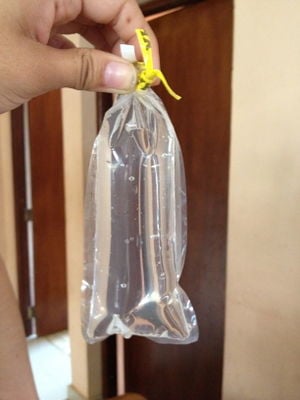
Calculations
- V: Volume of calculation
- R: Precipitation
- A: Foot Print of Collection Surface
- k: Conversion from to gal
- e: Efficiency of collection surface [10]
Climate in The Dominican Republic
Temperature
The northern areas of the Dominican Republic tend to see the greatest amount of rainfall whereas the southern areas of the Dominican Republic tend to be very hot and dry.[11] The average high temperature per year is 86 degrees Fahrenheit and the average low temperature per year is 70 degrees Fahrenheit.[12]
Hurricanes
Hurricanes pose a great threat to the island. Routes and patterns of the hurricanes are unpredictable, but the greatest danger comes in August and September, when hurricanes can last two weeks. [13]
Rainfall
The average annual rainfall for the Dominican Republic is 150cm[14]
Las cifras indican que en 50 años la ponderación de la intensidad de lluvia máxima para el diseño de las obras hidráulicas en el país se ha incrementado en un 40%”, expresan los técnicos.[15] {Rainfall intensity has increased by 40% within the last 50 years.}
Design
The rainwater catchment system in La Yuca is composed of 6 main parts; the area of catchment, the gutter, primary screening, first flush, the storage unit, and the filtration.
| Area of Catchment
The La Yuca rainwater catchment system uses the galvanized steel roof of La Yuca appropriate building as its catchement area. The system catchment area is approximately 175 ft2 (16 m2). The use of a steel roof galvanized in zinc reduces the amount of rust that will appear on the area of catchment and enters the system. |
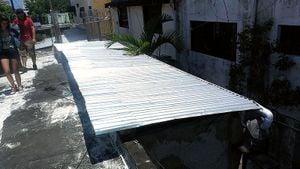
|
| The Gutter
A 3inch PVC pipe is used for the gutter. The PVC pipe is cut down the middle and then attached to the area of catchment using wire to keep the gutter in place. Secured at the end of the gutter is a 90 degree PVC pipe to ensure that the runoff water flows directly into the primary screening and then enters the first flush. |
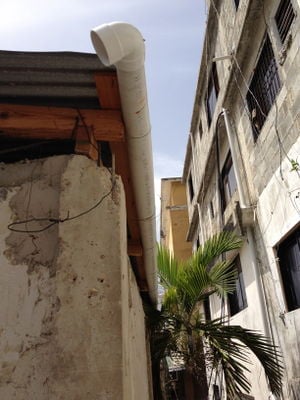
|
| Primary Screening
To construct the primary screening a 5 gallon jug commonly known as a botellon is used. The botellon is glued upside down to a PVC pipe feeding into the first flush. The bottom of the bottelion is cut at an angle. Attached to the bottom of the botellon is chicken wire and a tight knit screen. On the inside of the botellon is stainless steel drain filter to help catch objects and prevent them from entering into the first flush, in case the first two screens undergo damage |
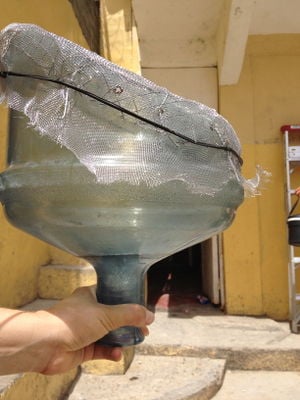
|
| First Flush
The first flush is constructed of a 3" PVC pipe that feeds into a tee section. Within the 3 PVC pipe is a ball valve that shuts off access to the first flush, when water in the first flush has reached the maximum capacity of water required to clean the area of catchment. Two 5 gallon botellones are connected to the bottom of the PVC pipe. In the bottom of the botellones are small holes that allow contaminated water to leave the system slowly. Above the botellones are connectors that attach the pvc pipes, these connectors make it simple to take the first flush apart if necessary to check for potential problems, without causing damage to the rest of the system. The botellones used in the bottom of the first flush are painted to reduce the growth of algae from exposure to sunlight. |
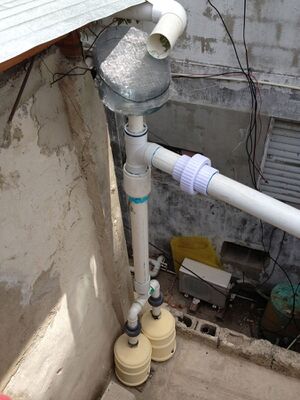
|
| Storage Unit
A tinaco is used for the storage unit of the system. Tinacos are commonly used throughout the Dominican Republic to provide municipal water when power shortages occur. Tinaco's are located on the rooftops of houses to provided water pressure when needed for sinks, faucets, and toilets. The tinaco is raised onto cinder blocks to provide more head for the system. To ensure that the tinaco is secure, wire is used to tie the tinaco to the cinder blocks and bags of sand are used to way down the storage unit. |
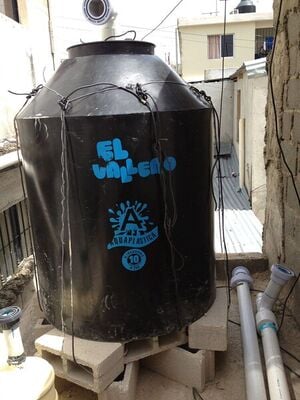
|
| Overflow
An overflow is provided on the side of the tinaco. To prevent larva and other small insects from entering the storage unit, a pipe with a small knit screen attached to the overflow. This method will prevent mosquitos from laying eggs on the side of the overflow that may eventually fall into the storage tank when the water level in the tinaco is low. |
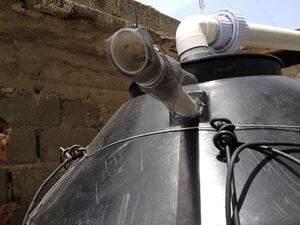
|
| Liter of Light
We used this method where the pipes go through the roof to the filters. An 8 inch by 9.5 inch sheet of scrap metal was cut and glued with silicon to the galvanized aluminum roof to seal and prevent water from leaking through to the filtration. |
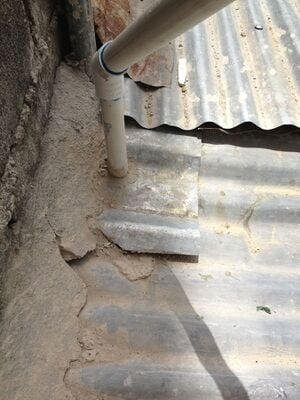 |
| Filtration
A sediment filter is used to filter out any remaining particles that maybe left in the runoff water coming from the storage unit. A silver impregnated carbon filter is used to kills pathogens and bacteria present in the water. |
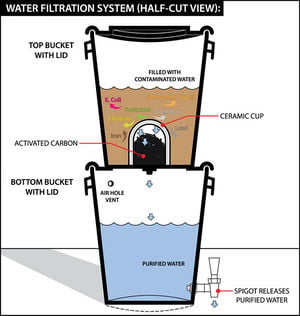
|
Calculations
The equation is used to determine the size of tank necessary for the storage unit.
Cost
| Material | Quantity | Unit Cost (DOP) | Total Cost (DOP) |
|---|---|---|---|
| PVC 3" (29ft) | 1 | 1600 | 1600 |
| PVC 1" (5ft) | 1 | 70 | 70 |
| PVC 1/2" (5ft) | 1 | 50 | 50 |
| 5 Gallon Jug | 3 | 250 | 750 |
| 90 Degree- 3" PVC | 1 | 150 | 150 |
| 90 Degree- 1/2" PVC | 3 | 5 | 15 |
| T Branch- 3" PVC | 1 | 125 | 125 |
| T Branch- 1" PVC | 1 | 15 | 15 |
| 90 Degree- 1" PVC | 5 | 12 | 60 |
| 45 Degree- 1" PVC | 2 | 11 | 22 |
| Junta- 1/2" PVC | 1 | 22 | 22 |
| Junta- 1" PVC | 1 | 51 | 102 |
| Junta- 2' PVC | 2 | 227 | 454 |
| Junta- 3' PVC | 2 | 290 | 580 |
| Connectors PVC | 6 | 20 | 120 |
| Epoxy/Silicon | 2 | 150 | 300 |
| Cinder Blocks | 20 | 20 | |
| Shut off valves | 2 | 350 | 700 |
| Activated Carbon bucket Filter | 1 | 1600 | 1600 |
| Ball valve | 1 | donated | - |
| Spigot | 2 | 235 | 470 |
| Tinaco | 1 | 3800 | 3800 |
| Total Cost | 11005 |
Buy Back
Next Steps
Discussion
Project Timeline
June 9, 2012
- Started Project
- Measured all pipe lengths, diameters, and calculate the volumes of the first flush and container.
- Tested flow rate of the filtered water out of the slow sand filter.
June 10, 2012
- Set Criteria.
June 11, 2012
- Formulated plans.
- Generated alternative designs.
June 13, 2012
- Discussed plans with a community member (Oswaldo)
- Looked at gutter systems nearby especially ones with sediment traps.
June 16, 2012
- Experimented with first flush containers that could be the correct size.
June 18, 2012
- Search for student participation in water testing.
June 19, 2012
- Plan filter installation.
How to build your own
References
- ↑ http://www.rwh.in/healthissues.htm
- ↑ http://www.twdb.state.tx.us/publications/reports/RainwaterHarvestingManual_3rdedition.pdf
- ↑ http://www.twdb.state.tx.us/publications/reports/RainwaterHarvestingManual_3rdedition.pdf
- ↑ http://www.kindredcommunity.com/articles/the-liter-of-light-project-turns-waste-plastic-bottles-into-solar-bulbs/p/2287
- ↑ 5.0 5.1 5.2 http://www.twdb.state.tx.us/publications/reports/rainwaterharvestingmanual_3rdedition.pdf
- ↑ http://practicalaction.org/docs/technical_information_service/rainwater_harvesting.pdf
- ↑ Davis, M. (2010). Water and wastewater engineering : design principles and practice.
- ↑ Ireland EPA WATER TREATMENT MANUALS FILTRATION
- ↑ http://www.twdb.state.tx.us/publications/reports/RainwaterHarvestingManual_3rdedition.pdf
- ↑ http://raintankdepot.com/pdf/rainwater-catchment-standards.pdf
- ↑ http://dominican.peacecorps.gov/pcdr.php
- ↑ http://dominicanrepublic-guide.info/weather/
- ↑ http://www.peacecorps.gov/wws/publications/insights/.../InsightsBackground.pdf
- ↑ http://www.nrel.gov/wind/pdfs/27602.pdf
- ↑ http://www.hoy.com.do/el-pais/2010/1/24/311243/print
- ↑ http://www.ldsglo.com/forum/showthread.php?t=12123





















